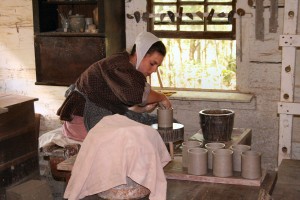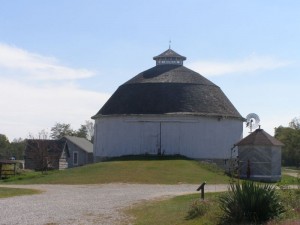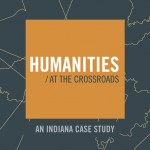Humanities at the Crossroads: The Indiana case study
28 July 2014 – Nancy Conner
Editor’s Note: This is the fourth piece in a series on the “crisis” in the humanities. A post introducing the series can be found here.

Pottery wheel demonstration at Conner Prairie living history museum in Fishers, Indiana.
Photo credit: Derek Jensen
In the past few years, the airwaves have been filled with angst about the state of the humanities, primarily in college and university humanities departments. Humanities at the Crossroads (HAC), a national initiative to examine the future of the humanities in American life, was one of several responses to the crisis. The HAC planning group, however, felt that more research was needed, and they decided to focus on a single state, Indiana, as a case study.
Indiana Humanities became the lead organization for the Indiana Case Study. What could we find out about the humanities in Indiana? It was like the KWL exercise that educators use: What do we know? What do we want to know? What did we learn?
Having been in the humanities business for more than 40 years, we do know the main organizations that support the public humanities in Indiana, those most likely to be involved in history, literature, philosophy, and related fields. These include colleges and universities, schools, museums and historic sites, historical organizations, preservation groups, libraries, ethnic associations, arts councils, public media, state and local government agencies, and community foundations. Working with statewide partners, Indiana Humanities took on the job of compiling a database of these groups, which eventually amounted to more than 1,800 records.

Burt Leedy, Round Barn, Fulton County History Museum, Rochester, Indiana. Photo credit: Chris Light.
That was the first finding. Our research highlighted the fact that there are humanities-related organizations in each of Indiana’s 92 counties. Although not every county has a college or university, by and large they do tend to have most of the other types of institutions, comprising a permanent infrastructure for the humanities. So, with the help of the Center for Information and Research on Civic Learning and Engagement (CIRCLE) at Tufts University’s Jonathan M. Tisch College of Citizenship and Public Service, we set out to take a survey of these organizations.
What did we want to know? We asked for basic data about organizational history, budget, staff and board, and geographic reach, as well information about audiences, activities, and collaborations. In addition, we asked respondents for their perceptions of how the humanities are viewed in their communities. The objective was to get a reading on the substance, scope, and health of the humanities in Indiana and to create a model that could be used in other states. In the end, 390 organizations submitted usable surveys.
History, we soon learned, is by far the most widely practiced discipline in the humanities. More than 80 percent of the survey respondents offered some programs or activities related to history. Of these programs, 69 percent were in local history, with 48 percent in state history and 47 percent in family history, genealogy, and cultural heritage. These figures contrasted with much lower numbers for architecture (27 percent), art (26 percent), literature (24 percent), and archaeology (22 percent).
 But there was more. The full-length report pointed out that “Furthermore, ‘history’ may be a broader category than it appears. Respondents mentioned offering a wide range of activities, including services directly related to history (maintaining sites and records, preservation, offering historical tours), but also many civic opportunities (discussions, volunteering, dialogue), connections to core public institutions (libraries and schools), and appreciations of culture (folklife, cultural awareness, cultural heritage, festivals)… In the academy and in federal law, the humanities are defined as disciplines, but when tied to civic life – to the needs of citizens rather than scholars or students – they are actively appropriated (and primarily valued) as practices, such as public discussion, that cross disciplinary lines. Given the importance of these activities for public discourse and community engagement, the public humanities can be considered essential conveners of civic life. These organizations thus can be seen as civic hubs” (p. 6). (The executive summary of the report is available here.)
But there was more. The full-length report pointed out that “Furthermore, ‘history’ may be a broader category than it appears. Respondents mentioned offering a wide range of activities, including services directly related to history (maintaining sites and records, preservation, offering historical tours), but also many civic opportunities (discussions, volunteering, dialogue), connections to core public institutions (libraries and schools), and appreciations of culture (folklife, cultural awareness, cultural heritage, festivals)… In the academy and in federal law, the humanities are defined as disciplines, but when tied to civic life – to the needs of citizens rather than scholars or students – they are actively appropriated (and primarily valued) as practices, such as public discussion, that cross disciplinary lines. Given the importance of these activities for public discourse and community engagement, the public humanities can be considered essential conveners of civic life. These organizations thus can be seen as civic hubs” (p. 6). (The executive summary of the report is available here.)
Perhaps because of this vital function, respondents were surprisingly optimistic about their roles within the local community and opportunities for growth and sustainability. As small towns across America continue to struggle for recognition and viability, they value public history as a unique source of civic identity.
Our survey also found that the word “humanities” is very rarely used by public institutions and, in fact, is avoided. Google the term “humanities” and, apart from articles on the “crisis,” your search will reveal few if any websites that are not run by universities, national humanities agencies, or state humanities councils.
Some other data: 83 percent of the surveyed organizations were at least 20 years old, and 22 percent had been in existence for 100 or more years. The majority were small: 63 percent reported having five or fewer full-time staff members, and 29 percent had no full-time staff. Funding was a continuing issue, with income for 90 percent of respondents either flat or in decline. Sources included individuals (64 percent), foundations (47 percent), state government (41 percent), and federal government (21 percent).
What we wanted to learn most of all, however, was something about the configuration of Indiana’s humanities networks, what we called the humanities “ecosystem.” That is, we wanted to know how – or whether – these organizations collaborated with each other. Although Indiana Humanities, the Indiana Historical Society and/or Indiana Landmarks connect to 73 percent of the survey respondents, the analysis that CIRCLE provided (using Gephi, a social network analysis software) revealed an overall structure that was not very dense or highly clustered.
This is clearly where there is more to do. Networks such as the National Council on Public History, state humanities councils and other agencies with a mandate to serve entire states must try to reach more of their county-level constituents with information and resources. This work is ongoing because as staff turnover occurs, relationships constantly need to be built and rebuilt.
~ Nancy Conner is Director of Grants, Indiana Humanities.




2 comments